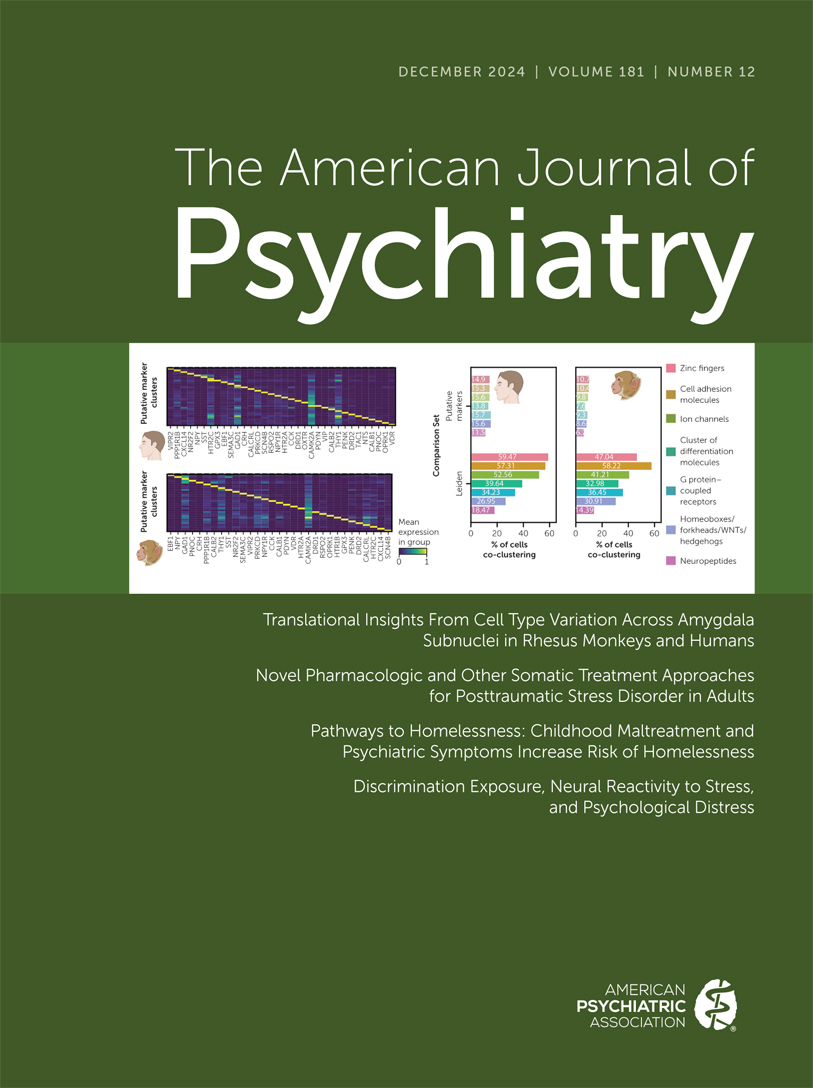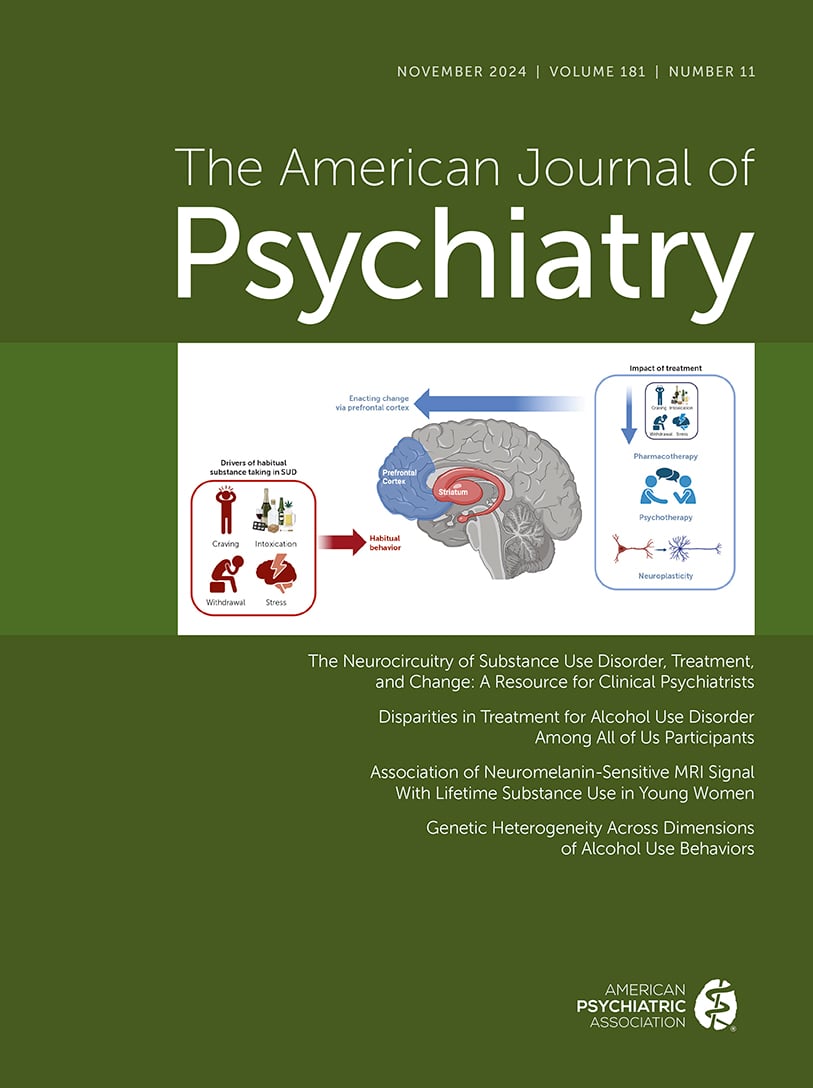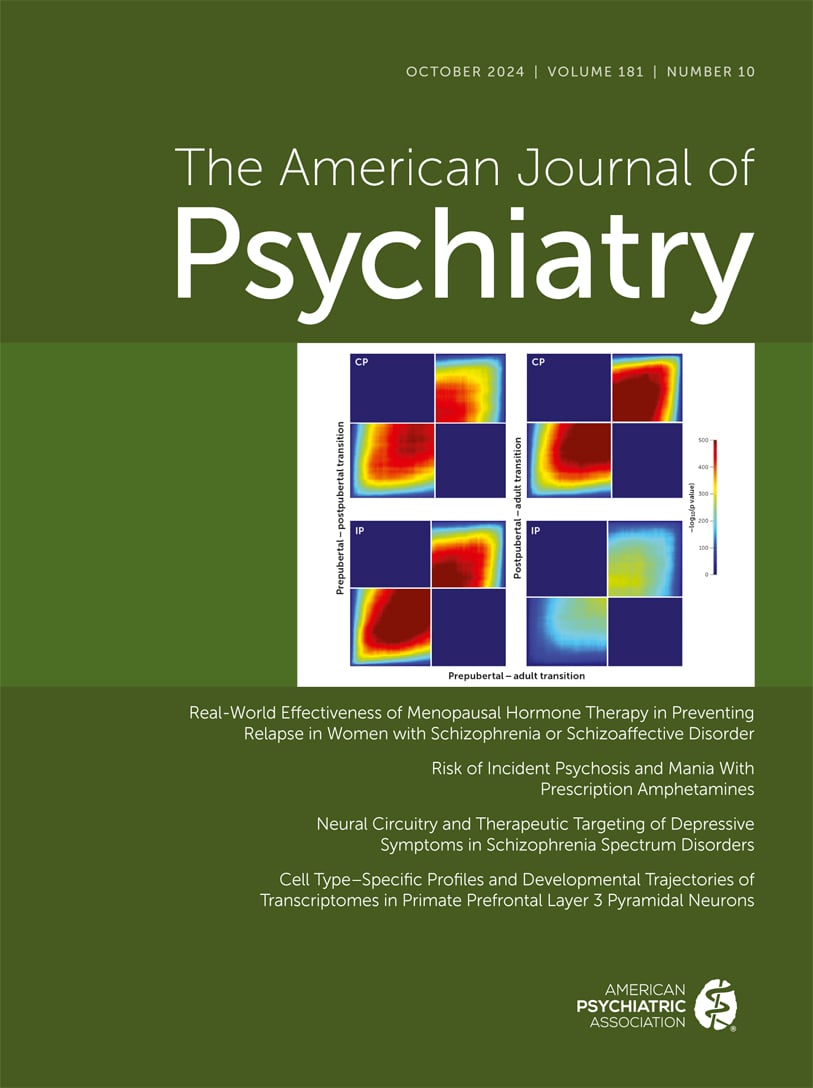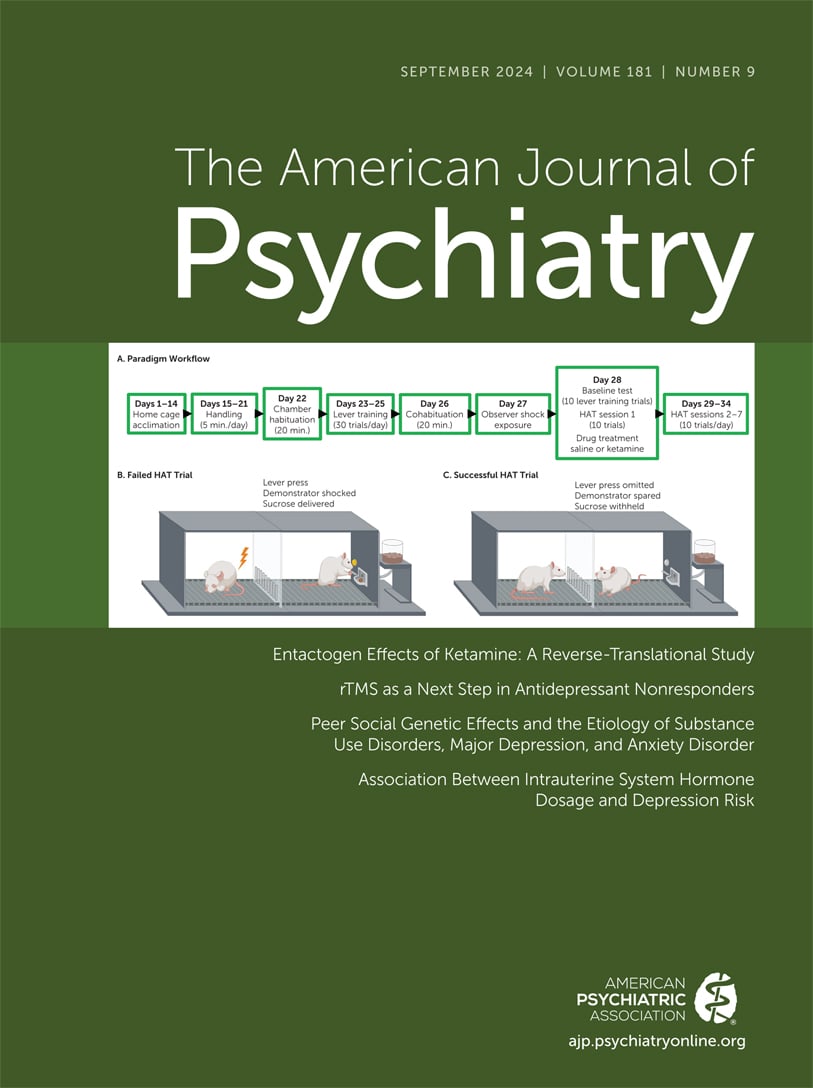American Journal of Psychiatry
- Volume 163
- Number 3
- March 2006
In This Issue
Editorials
Reviews and Overviews
Publication date: 01 March 2006
Pages365–373OBJECTIVE: A growing body of evidence supports the use of cognitive behavior therapy for the treatment of schizophrenia. A course of cognitive behavior therapy, added to the antipsychotic regimen, is now considered to be an appropriate standard of care in ...
https://doi.org/10.1176/appi.ajp.163.3.365Introspections
Treatment in Psychiatry
Clinical Case Conference
Images in Psychiatry
Article
Publication date: 01 March 2006
Pages387–395OBJECTIVE: The abuse potential of methylphenidate has been related to the drug’s capacity to produce a rapid onset of blockade of the presynaptic dopamine transporter in the brain. An oral once-a-day osmotic controlled-release formulation of ...
https://doi.org/10.1176/appi.ajp.163.3.387Publication date: 01 March 2006
Pages396–401OBJECTIVE: Long-acting injectable risperidone represents the first clinically available depot atypical antipsychotic. The present study used positron emission tomography (PET) to evaluate its dopamine D2 binding profile at doses of 25, 50, or 75 mg ...
https://doi.org/10.1176/appi.ajp.163.3.396Publication date: 01 March 2006
Pages402–410OBJECTIVE: The authors compared the effects of maintenance versus withdrawal of risperidone treatment in children and adolescents with symptoms of disruptive behavior disorder. METHOD: Patients with disruptive behavior disorder (5–17 years of age and a ...
https://doi.org/10.1176/appi.ajp.163.3.402Publication date: 01 March 2006
Pages411–417OBJECTIVE: There is growing interest in identifying and surmounting barriers to employment for people with schizophrenia. The authors examined factors associated with participation in competitive employment or other vocational activities in a large group ...
https://doi.org/10.1176/appi.ajp.163.3.411Publication date: 01 March 2006
Pages418–425OBJECTIVE: Impairments in adaptive life skills are a major source of disability in patients with schizophrenia. The relationship between adaptive life skills in real-world settings and performance on neuropsychological tests may be complicated by other ...
https://doi.org/10.1176/appi.ajp.163.3.418Publication date: 01 March 2006
Pages426–432OBJECTIVE: Interview-based measures of cognition may serve as potential coprimary measures in clinical trials of cognitive-enhancing drugs for schizophrenia. However, there is no such valid scale available. Interviews of patients and their clinicians are ...
https://doi.org/10.1176/appi.ajp.163.3.426Publication date: 01 March 2006
Pages433–441OBJECTIVE: This study assessed the relationship between symptoms and cognitive measures at intake and functional outcome 2–8 years later (average 3 years) in first-episode and previously treated schizophrenia patients. METHOD: A composite cognitive score ...
https://doi.org/10.1176/appi.ajp.163.3.433Publication date: 01 March 2006
Pages442–447OBJECTIVE: Deficits in emotion processing are a hallmark of schizophrenia, with consequences for social functioning and subjective well-being. However, their specificity and characteristics have not been ascertained psychometrically. The authors’ purpose ...
https://doi.org/10.1176/appi.ajp.163.3.442Publication date: 01 March 2006
Pages448–454OBJECTIVE: The potential of social cognition as a mediator of relations between neurocognition and functional status in schizophrenia has been suggested by correlational studies that link neurocognition to social cognition or link social cognition to ...
https://doi.org/10.1176/appi.ajp.163.3.448Publication date: 01 March 2006
Pages455–462OBJECTIVE: Schizophrenia impairs many cognitive functions, including face perception. Veridical face perception is critical for social interaction, including distinguishing friend from foe and familiar from unfamiliar faces. The main aim of this study was ...
https://doi.org/10.1176/appi.ajp.163.3.455Publication date: 01 March 2006
Pages463–469OBJECTIVE: Functional and structural magnetic resonance imaging (MRI) was used to investigate relationships among structure, functional activation, and cognitive deficits related to the thalamus in individuals with schizophrenia and healthy comparison ...
https://doi.org/10.1176/appi.ajp.163.3.463Publication date: 01 March 2006
Pages470–477OBJECTIVE: Normal sex differences in language functions are disrupted in schizophrenia. However, identification of specific language components most vulnerable in schizophrenia and how they may differ by sex remain unexamined. The current study ...
https://doi.org/10.1176/appi.ajp.163.3.470Publication date: 01 March 2006
Pages478–487OBJECTIVE: Schizophrenia and psychotic bipolar disorder have a number of overlapping symptoms and risk factors, but it is not yet clear if the disorders are characterized by similar deviations in brain morphometry or whether any such deviations reflect ...
https://doi.org/10.1176/appi.ajp.163.3.478Publication date: 01 March 2006
Pages488–493OBJECTIVE: Despite the clinical observation that antipsychotics can produce negative symptoms, no previous controlled study, to our knowledge, has evaluated this action in healthy subjects. The present study assessed observer-rated and self-rated negative ...
https://doi.org/10.1176/appi.ajp.163.3.488Publication date: 01 March 2006
Pages494–499OBJECTIVE: Antipsychotic-induced erectile dysfunction is a significant clinical problem and is a common reason for poor medication compliance. This report studied the efficacy and tolerability of sildenafil citrate in patients with antipsychotic-induced ...
https://doi.org/10.1176/appi.ajp.163.3.494Publication date: 01 March 2006
Pages500–506OBJECTIVE: “Therapeutic misconception,” or conflation of goals and procedures of clinical research with those of usual clinical care, is an important topic in research ethics because it may impede informed consent. How best to assess therapeutic ...
https://doi.org/10.1176/appi.ajp.163.3.500Publication date: 01 March 2006
Pages507–511OBJECTIVE: The 32-bp deletion allele in chemokine receptor CCR5 has been associated with several immune-mediated diseases and might be implicated in schizophrenia as well. METHOD: The authors genotyped DNA samples from 268 schizophrenia patients and 323 ...
https://doi.org/10.1176/appi.ajp.163.3.507Publication date: 01 March 2006
Pages512–520OBJECTIVE: The authors’ goal was to improve the diagnosis of schizophrenia by using virtual reality technology to build a complex, multimodal environment in which cognitive functions can be studied (and measured) in parallel. METHOD: The authors studied ...
https://doi.org/10.1176/appi.ajp.163.3.512Publication date: 01 March 2006
Pages521–528OBJECTIVE: Individuals with schizophrenia and their relatives tend to have either higher or lower than expected prevalences of autoimmune disorders, especially rheumatoid arthritis, celiac disease, autoimmune thyroid diseases, and type 1 diabetes. The ...
https://doi.org/10.1176/appi.ajp.163.3.521Brief Report
Publication date: 01 March 2006
Pages529–531OBJECTIVE: All antipsychotics act on the dopamine D2 receptor. The present study extends prior pharmacogenetic investigations of the D2 receptor gene (DRD2) by examining, in first-episode schizophrenia patients, promoter region variation as a predictor of ...
https://doi.org/10.1176/appi.ajp.163.3.529Publication date: 01 March 2006
Pages532–534OBJECTIVE: Converging evidence has demonstrated an association between variants in the dysbindin gene (DTNBP1) and schizophrenia. Recently, a DTNBP1 risk haplotype, associated with both schizophrenia and neurocognitive dysfunction, has been identified. ...
https://doi.org/10.1176/appi.ajp.163.3.532Publication date: 01 March 2006
Pages534–537OBJECTIVE: In the prefrontal cortex of subjects with schizophrenia, decreased signaling mediated by brain-derived neurotrophic factor (BDNF) and its receptor tyrosine kinase (TrkB) appears to contribute to the reduced expression of mRNA encoding the 67-...
https://doi.org/10.1176/appi.ajp.163.3.534Publication date: 01 March 2006
Pages537–539OBJECTIVE: Previous studies linking the catechol O-methyltransferase (COMT) functional polymorphism to the specific phenotype in 22q11.2 deletion syndrome (22q11.2DS) have yielded inconsistent results. The goal of the present study was to replicate a ...
https://doi.org/10.1176/appi.ajp.163.3.537Publication date: 01 March 2006
Pages540–542OBJECTIVE: The authors’ goals were to establish the cellular origin of the reduced cortical reelin expression that occurs in schizophrenia and to relate it to markers of synaptic pathology. METHOD: In situ hybridization was used to quantify reelin mRNA in ...
https://doi.org/10.1176/appi.ajp.163.3.540Publication date: 01 March 2006
Pages543–545OBJECTIVE: Deficiency in antisaccade performance has been proposed as a schizophrenia endophenotype. METHOD: The authors assessed performance on an antisaccade task (and a prosaccade control condition) by 10 monozygotic twin pairs discordant for DSM-IV ...
https://doi.org/10.1176/appi.ajp.163.3.543Letter to the Editor
Correction
Book Forum
Books Received
Past Issues
View Issues Archive
Vol. 181 | No. 12

Vol. 181 | No. 11

Vol. 181 | No. 10
